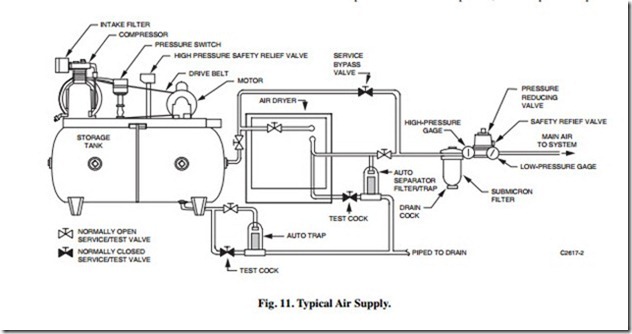AIR SUPPLY EQUIPMENT
GENERAL
A pneumatic control system requires a supply of clean, dry, compressed air. The air source must be continuous because many pneumatic sensors, controllers, relays, and other devices bleed air. A typical air supply system includes a compressor, an air dryer, an air filter, a pressure reducing valve, and air tubing to the control system (Fig. 11).
The following paragraphs describe the compressor, filter, pressure reducing valves, and air drying techniques. For information on determining the moisture content of compressed air, refer to the General Engineering Data section.
The controlling pressure is connected at the pilot port (P), and pressures to be switched are connected at the normally connected port (O) or the normally disconnected port (X).The operating point of the relay is set by adjusting the pring pressure at the top of the relay.When the pressure at the pilot port reaches the relay operating point, it pushes up n the diaphragm in the controlchamber and connects pressure on the normally disconnected port (X) to the common port as shown. If the pilot pressure falls below the relay set point, the diaphragm moves down, blocks the normally is connected (X) port, and connects the normally connected port (O) to the common port.
AIR COMPRESSOR
The air compressor provides the power needed to operate all control devices in the system. The compressor maintains pressure in the storage tank well above the maximum required in the control system. When the tank pressure goes below a minimum setting (usually 70 to 90 psi), a pressure switch starts the compressor motor. When the tank pressure reaches a high- limit setting, the pressure switch stops the motor. A standard tank is typically large enough so that the motor and compressor operate no more than 50 percent of the time, with up to twelve motor starts per hour.
Some applications require two compressors or a dual compressor. In a dual compressor, two compressors operate
alternately, so wear is spread over both machines, each capable of supplying the average requirements of the system without operating more than half the time. In the event of failure of one compressor, the other assumes the full load.
Contamination in the atmosphere requires a compressor intake filter to remove particles that would damage the compressor pump. The filter is essential on oil-less compressors because a contaminated inlet air can cause excessive wear on piston rings. The intake filter is usually located in the equipment room with the compressor, but it may be located outdoors if clean outdoor air is available. After the air is compressed, cooling and settling actions in the tank condense some of the excess moisture and allow fallout of the larger oil droplets generated by the compressor pump.
A high pressure safety relief valve which opens on excessively high tank pressures is also required. A hand valve or automatic trap periodically blows off any accumulated moisture, oil residue, or other impurities that collect in the bottom of the tank.
